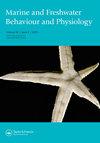Impacts of elevated water temperatures on righting behavior and survival of two freshwater caenogastropod snails
IF 0.9
4区 生物学
Q3 MARINE & FRESHWATER BIOLOGY
Marine and Freshwater Behaviour and Physiology
Pub Date : 2018-07-04
DOI:10.1080/10236244.2018.1538699
引用次数: 3
Abstract
ABSTRACT As global temperatures rise, streams and rivers are predicted to be more severely impacted than other ecosystems, due in part to the limited mobility of aquatic invertebrates. Compared to many terrestrial animals, freshwater snails have particularly low potential for migration and thus are not expected to be able to compensate for climate warming with active dispersal. In freshwater animals, several behaviors are affected by elevated temperatures, including burrowing and escape responses, among others. This laboratory study aimed to assess the impacts of elevated temperatures on righting behavior and survival in two species of freshwater caenogastropod snails: fine-ridged elimia (Elimia semicarinata) and Shawnee rocksnails (Lithasia obovata). Righting time (the time to turn the body right-side-up when placed on the dorsal side of the shell) was assessed before beginning the experiment and again after chronic (10 day) exposure to an elevated temperature. There was no significant change in righting time at any temperature for either species, but there was significantly more failure to right within the time limit at elevated temperatures. For fine-ridged elimia, 30% of the snails failed to right in 30°C, compared to 2.5% in the control temperature (20°C). Similarly, 47.8% of Shawnee rocksnails failed to right at 27°C, while 19.4% failed to right in the 20°C group. Mortality was significantly higher at 35°C for fine-ridged elimia and 30°C for Shawnee rocksnails compared to the mortality of each species’ control group. Predicted rates of climate warming and current average temperatures suggest that fine-ridged elimia face more imminent risk of large-scale failure to right within natural populations, but the lower lethal temperature for Shawnee rocksnails suggests relatively high risk as well. These results contribute to the growing body of evidence that freshwater snails will be negatively impacted by climate warming, and may face large losses in the years to come.水温升高对两种淡水海腹足类蜗牛矫直行为和生存的影响
随着全球气温上升,预计河流和溪流将比其他生态系统受到更严重的影响,部分原因是水生无脊椎动物的流动性有限。与许多陆生动物相比,淡水蜗牛的迁移潜力特别低,因此预计无法通过主动扩散来补偿气候变暖。在淡水动物中,一些行为受到温度升高的影响,包括挖洞和逃跑反应等。本实验旨在评估温度升高对两种淡水沼足纲蜗牛:细脊岩螺(elimia semicarinata)和肖尼岩螺(Lithasia obovata)的矫直行为和生存的影响。在实验开始前和长期(10天)暴露于高温后评估翻身时间(放置在贝壳背面时将身体翻转过来的时间)。在任何温度下,两种植物的翻身时间都没有显著变化,但在高温下,在时间限制内的翻身失败明显更多。在30°C条件下,30%的细脊型钉螺无法矫正,而在对照温度(20°C)下,这一比例为2.5%。同样,在27°C条件下,47.8%的肖尼岩螺不能右转,而在20°C条件下,19.4%的肖尼岩螺不能右转。在35°C和30°C条件下,细脊岩螺和肖尼岩螺的死亡率显著高于各物种对照组的死亡率。预测的气候变暖率和目前的平均气温表明,细脊灭绝面临着更紧迫的大规模失败的风险,在自然种群中,但肖尼岩螺的致命温度较低,也表明风险相对较高。这些结果提供了越来越多的证据,表明淡水蜗牛将受到气候变暖的负面影响,并可能在未来几年面临巨大的损失。
本文章由计算机程序翻译,如有差异,请以英文原文为准。
求助全文
约1分钟内获得全文
求助全文
来源期刊

Marine and Freshwater Behaviour and Physiology
生物-海洋与淡水生物学
CiteScore
2.10
自引率
0.00%
发文量
9
审稿时长
>12 weeks
期刊介绍:
Marine and Freshwater Behaviour and Physiology is devoted to the publication of papers covering field and laboratory research into all aspects of the behaviour and physiology of all marine and freshwater animals within the contexts of ecology, evolution and conservation.
As the living resources of the world’s oceans, rivers and lakes are attracting increasing attention as food sources for humans and for their role in global ecology, the journal will also publish the results of research in the areas of fisheries biology and technology where the behaviour and physiology described have clear links to the contexts mentioned above.
The journal will accept for publication Research Articles, Reviews, Rapid Communications and Technical Notes (see Instructions for authors for details). In addition, Editorials, Opinions and Book Reviews (invited and suggested) will also occasionally be published. Suggestions to the Editor-In-Chief for Special Issues are encouraged and will be considered on an ad hoc basis.
With the goal of supporting early career researchers, the journal particularly invites submissions from graduate students and post-doctoral researchers. In addition to recognising the time constraints and logistical limitations their research often faces, and their particular need for a prompt review process, accepted articles by such researchers will be given prominence within the journal (see Instructions for authors for details).
 求助内容:
求助内容: 应助结果提醒方式:
应助结果提醒方式:


